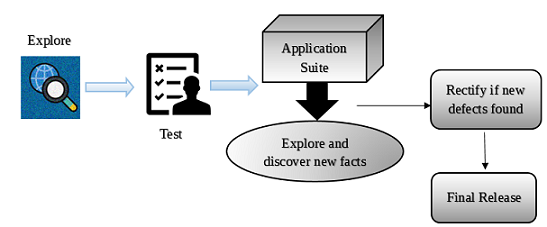

This testing is about exploring a software component, also termed as context based approach.Exploratory testing can be conducted any time irrespective of the phase it is in. An efficient exploratory tester is the one who keeps applying his ideas and thoughts on the basis of past experiences or previous mistakes, and prepares a list of those factors so as to apply them to application testing.
The main objective of exploratory testing is to enable learning about the software application being developed. It is not a preplanned approach, contrary to what scripted testing is. This type of testing is carried out in case we have limited time with no prior documentation. Exploratory testing is an agile approach which is dynamic and quite spontaneous in nature in contrast to the traditional form of testing.

Note: Exploratory testing aims to design and execute tests simultaneously, an unplanned and spontaneous form of testing that helps to uncover facts.
This technique involves pre-planning of each subsequent steps to be followed in the execution of test plan for a specific component. A QA prepares test cases and also explains what would be the outcome of the overall test plan.
Hence scripted testing is a systematic approach to conduct testing of an application, in a well documented manner. Scripted tests are mostly automated , thus can be performed by testers who are new to testing.

Exploratory testing is an approach most suitable in the early phases of development, where coding of software components have just begun. In order to keep an eye on defects and to take corrective measures on a timely basis, exploratory testing serves the purpose. A constant urge to find out bugs, finding ways to mitigate the faults occurring, enables one to develop a deep understanding of the flow of a program. It is a very effective approach to agile environments, where changes are dynamic. Testing is to be done within very limited time periods.
Scripted testing on the contrary relies on a planned set of test cases. It is carried out in the light of a certain kind of test scenario, with test scripts meant to find bugs in a particular software component.
Exploratory testing has evolved in new ways over the past few years. There have been many standards defined in this context. Following are the few formal methods.
A testing approach is selected keeping in mind few important factors. These are :
The aforementioned points are key areas to be analyse prior selecting either of the testing approaches. This shall help to direct testing in the right and most appropriate way.
Testing is an inevitable part of software's life cycle. Hence the right kind of approach must be applied for the purpose of choosing the right testing. As explained earlier, exploratory style of testing needs less documentation, requires analytical skills of testers and a limited time, it is thus a continuous process of learning along with test design and test execution.
Scripted testing is basically an automation process which aims at a planned test activity with detailed test case, test specifications and test design. Scripted testing facilitates the scope for predictability. A tester working on scripted testing can produce a written document of bug reports.
Advertisement: